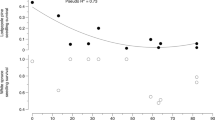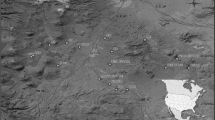Abstract
Invasion of globally threatened ecosystems dominated by arbuscular mycorrhizal plants, such as the alkaline prairies and serpentine barrens of eastern North America, by species of ectomycorrhizal (ECM) pine (Pinus) seriously threatens the persistence, conservation, and ongoing restoration of these rare plant communities. Using Maryland serpentine barrens and an Ohio alkaline prairie complex as model systems, we tested the hypothesis that the invasiveness of Virginia pine (Pinus virginiana L.) into such communities is regulated by the spatial pattern of ECM fungal inoculum in the soil. ECM colonization of pine seedlings can occur by (1) hyphae growing from the roots of mature ECM pines colonizing nearby seedlings (contagion model), (2) pine seedlings being infected after germinating in open areas where spores are concentrated in feces of animals that have consumed sporocarps (centers of infection model), and (3) colonization from spores that are wind-dispersed across the landscape (background model). To test these models of dispersal of ECM fungal inoculum into these barrens, we used autocorrelation and spatially explicit mapping techniques (semivariance analysis and kriging) to characterize the distribution and abundance of ECM inoculum in soil. Our results strongly suggest that ECM fungi most often disperse into open barrens by contagion, thereby facilitating rapid pine colonization in an advancing front from mature pine forests bordering the barrens. Spatial patterns consistent with the centers of infection model were present but less common. Thus, current management techniques that rely on cutting and fire to reverse pine invasion may be ineffective because they do not kill or disrupt hyphal mats attached to mature roots of neighboring pines. Management alternatives are discussed.




Similar content being viewed by others
References
Agerer R (2001) Exploration types of ectomycorrhizae: a proposal to classify ectomycorrhizal mycelial systems according to their patterns of differentiation and putative ecological importance. Mycorrhiza 11:107–114
Alexander I, Ahmad N, Lee SS (1992) The role of mycorrhizas in the regeneration of some Malaysian forest trees. Philos Trans R Soc Lond 335:379–388
Allison LE (1965) Organic carbon. In: Klute A, Sparks DL, Weaver RW (eds) Methods of soil analysis part 2. American Society of Agronomy, Inc., Madison, WI, pp 1367–1378
Alway FJ, Kittredge J, Methley WJ (1933) Composition of the forest floor layers under different forest floor types on the same soil type. Soil Sci 35:387–398
Annala AE, Kapustka LA (1983) Photographic history of forest encroachment in several relict prairies at the Edge of Appalachia Preserve System, Adams County, Ohio. Ohio J Sci 83:109–114
Baar J, Horton TR, Kretzer AM, Bruns TD (1999) Mycorrhizal colonization of Pinus muricata from resistant propagules after a stand-replacing wildfire. New Phytol 143:409–418
Boerner REJ, DeMars BG, Leicht PN (1996) Spatial patterns of mycorrhizal infectiveness of soils along a successional chronosequence. Mycorrhiza 6:79–90
Bonello P, Bruns TD, Gardes M (1998) Genetic structure of a natural population of the ectomycorrhizal fungus Suillus pungens. New Phytol 138:533–542
Braun EL (1928) The vegetation of the Mineral Springs Region of Adams County, OH. Ohio Biol Surv Bull 15(5):517
Castellano MA, Trappe JM, Molina R (1985) Inoculation of container-grown Douglas-fir seedlings with basidiospores of Rhizopogon vinicolor and R. colossus: effects of fertility and spore application rate. Can J For Res 15:10–13
Cazares E, Trappe JM (1994) Spore dispersal of ectomycorrhizal fungi on a glacier forefront by mammal mycophagy. Mycologia 86:507–510
Choesin DN, Boerner REJ (2000) Vegetation and ground water alkalinity of Betsch Fen, a remnant periglacial fen in south central Ohio. Castanea 65:193–206
Claridge AW, Tanton MT, Sheebeck JH, Cork SJ, Cunningham RB (1992) Establishment of ectomycorrhizae on the roots of two species of Eucalyptus from fungal spores contained in the faeces of the long-nose potoroo (Totorous tridactylus). Austr J Ecol 17:207–217
Egerton-Warburton L, Allen MF (2001) Endo- and ectomycorrhizas in Quercus agrifolia Nee. (Fagaceae): patterns of root colonization and effects on seedling growth. Mycorrhiza 11:283–290
Finlay RD, Read DJ (1986) The structure and function of the vegetative mycelium of ectomycorrhizal plants. I. Translocation of 14C-labelled carbon between plants interconnected by a common mycelium. New Phytol 103:143–156
Fleming J (1983) Succession of mycorrhizal fungi on birch: infection of seedlings planted around mature trees. Plant Soil 71:263–267
Forman RTT (1995) Land mosaics: the ecology of landscapes and regions. Cambridge University Press, NY, p 632
Francis R, Read DJ (1994) The contributions of mycorrhizal fungi to the determination of plant community structure. Plant Soil 159:11–25
Gehring CA, Theimer TC, Whitham TG, Keim P (1998) Ectomycorrhizal fungal community structure of pinyon pines growing in two environmental extremes. Ecology 79:1562–1572
Geiger R (1965) The climate near the ground (Die Atmosphäre der Erde). Perthes Press, Darmstadt
Gamma Design Software (1992) GS+ Geostatistics for the environmental sciences, Version 3.1.7, professional Edition. Gamma Design Software, Plainwell, MI, USA
Hendershot WH, Lalande H, Duquette M (1993) Soil reaction and exchangeable acidity. In: Carter MR (ed) Soil sampling and methods of analysis. Canadian Society of Soil Science, CRC, Boca Raton, FL pp 141–145
Ingleby K, Mason PA, Last FT, Fleming LV (1990) Identification of ectomycorrhizas. Institute of terrestrial ecology (ITE) publication no. 5, natural environment research council, HMSO, London, UK
Isaaks EH, Srivastava RM (1989) An introduction to applied geostatistics. Oxford University Press, NY, p 561
Janos DP, Sahley CT, Emmons LH (1995) Rodent dispersal of vesicular-arbuscular mycorrhizal fungi in Amazonian Peru. Ecology 76:1852–1858
Jansen EJ, van Dobben HF (1987) Is decline of Cantharellus cibarius in the Netherlands due to air pollution? Ambio 16:211–213
Johnson CN (1996) Interactions between mammals and ectomycorrhizal fungi. Trends Ecol Evol 11:503–507
Kapustka LA, Annala AE (1982) An inventory of the prairies of the Edge of Appalachia preserve, Adams County, Ohio. Ohio Field Office of The Nature Conservancy, p 19
Knox RG (1984) Age structures of forests on Soldiers Delight, a Maryland serpentine area. Bull Torrey Bot Club 111:498–501
Kotter MM (1981) Interrelationships of tassel-eared squirrels, ponderosa pine, and hypogeous mycorrhizal fungi. M.S. thesis. The Ohio State University, Columbus, OH
Kotter MM, Farentinos RC (1984) Formation of ponderosa pine ectomycorrhizae after inoculation with feces of tassel-eared squirrels. Mycologia 76:758–760
Lapeyrie FF, Chilvers GA (1985) An endomycorrhiza–ectomycorrhiza succession associated with enhanced growth by Eucalyptus dumosa seedlings planted in a calcareous soil. New Phytol 100:93–104
Lonsdale WM (1999) Global patterns of plant invasions and the concept of invasibility. Ecology 80:1522–1536
Lutz HJ (1945) Vegetation on a trenched plot twenty-one years after establishment. Ecology 26:200–202
Marye WB (1955a) The great Maryland barrens I. MD Hist Mag 50:120–142
Marye WB (1955b) The great Maryland barrens II. Maryland Hist Mag 50:234–253
Maser C, Trappe JM, Nussbaum RA (1978) Fungal–small mammal interrelationships with emphasis on Oregon coniferous forests. Ecology 59:799–809
Molina R, Trappe JM (1982) Lack of mycorrhizal specificity by the ericaceous hosts Arbutus menziesii and Arctostaphylos uva-ursi. New Phytol 90:495–509
Molina R, Massicotte H, Trappe JM (1992) Specificity phenomena in mycorrhizal symbiosis: community–ecological consequences and practical implications. In: Allen MF (ed) Mycorrhizal functioning: an integrative plant–fungal process. Chapman & Hall, NY, pp 357–423
Morris SJ (1999) Spatial distribution of fungal and bacterial biomass in southern Ohio hardwood forest soils: fine scale variability and microscale patterns. Soil Biol Biochem 31:1375–1386
Newman EI, Ritz K, Jupp AP (1989) The functioning of roots in the grassland ecosystem. Aspects Appl Biol 22:263–269
Perry DA, Margolis H, Choquette C, Molina R, Trappe JM (1989) Ectomycorrhizal mediation of competition between coniferous tree species. New Phytol 112:501–511
Phillips JM, Hayman DS (1970) Improved procedures to clearing roots and staining parasitic and arbuscular mycorrhizal fungi for rapid assessment of infection. Trans Br Mycol Soc 55:158–161
Rankin M, O’Bryan D (1982) A preliminary survey of the rare and endangered species of the EOA preserve system, Adams County, OH. Internal report to the Ohio Chapter of The Nature Conservancy, p 89
Read DJ (1988) Development and function of mycorrhizal hyphae in soil. In: Sylvia DM, Hung LL, Graham JH (eds) Mycorrhizae in the next decade, practical applications and research priorities, Proc 7th NACOM. Institute of Food and Agricultural Sciences, University of Florida, Gainesville, FL, pp 176–180
Read DJ (1998) The mycorrhizal status of Pinus. In: Richardson DM (ed) Ecology and biogeography of Pinus. Cambridge University Press, NY, pp 324–340
Read DJ, Francis R, Finlay RD (1985) Mycorrhizal mycelia and nutrient cycling in plant communities. In: Fitter AH, Atkinson D, Read DJ, Usher MB (eds) Ecological interactions in soil: plants, microbes & animals. British Ecological Society Special Publication no. 4, Blackwell, Oxford, UK, pp 193–217
Reid CPP, Woods FW (1969) Translocation of 14C-labeled compounds in mycorrhizae and its implications in interplant nutrient cycling. Ecology 50:179–187
Rejmanek M, Richardson DM (1996) What attributes make some plant species more invasive? Ecology 77:1655–1661
Richardson DM, Bond WJ (1991) Determinants of plant distribution: evidence from pine invasions. Am Nat 137:639–668
Richardson DM, Williams PA, Hobbs RJ (1994) Pine invasions in the Southern Hemisphere: determinants of spread and invadability. J Biogeogr 21:511–527
SAS Institute, Inc (1996) SAS User’s Guide, Version 8.1. SAS Institute, Cary, NC
Sawyer NA, Chambers SM, Cairney JWG (2001) Distribution and persistence of Amanita muscaria genotypes in Australian Pinus radiata plantations. Mycol Res 105:966–970
Shreve F (1910) The plant life of Maryland. John Hopkins University Press, Baltimore, MD, p 533
Simard SW, Durall DM (2004) Mycorrhizal networks: a review of their extent, function, and importance. Can J Bot 82:1140–1165
Simard SW, Perry DA, Jones MD, Myrold DD, Durall DM, Molina R (1997) Net transfer of carbon between ectomycorrhizal tree species in the field. Nature 388:579–582
Simard SW, Jones MD, Durall DM (2002) Carbon and nutrient fluxes within and between mycorrhizal plants. In: van der Heijden MGA, Sanders I (eds) Mycorrhizal ecology. Springer, Berlin Heidelberg New York pp 33–74
Thiet RK (2002) Soil microbial community pattern and process: impacts on three plant communities of high conservation value. Ph.D. dissertation. The Ohio State University, Columbus, OH, p 217
Tuffen F, Eason WR, Scullion J (2002) The effect of earthworms and arbuscular mycorrhizal fungi on growth of and 32P transfer between Allium porrum plants. Soil Biol Biochem 34:1027–1036
Tuomey JW, Kienholz R (1931) Trenched plots under forest canopies. Yale Sch For Bull 30:31
Tyndall RW (1992) Historical considerations of conifer expansion in Maryland serpentine “barrens.” Castanea 57:123–131
Visser S (1995) Ectomycorrhizal fungal succession in jack pine stands following wildfire. New Phytol 129:389–401
Wallenstein MD (1996) Soil amelioration by Pinus virginiana during forest conversion on the New Texas serpentine barrens of Pennsylvania. Honors thesis. Franklin and Marshall College, Lancaster, PA, p 87
Wu B, Nara K, Hogetsu T (2001) Can 14C-labelled photosynthetic products move between Pinus densiflora seedlings linked by ectomycorrhizal mycelia? New Phytol 149:137–146
Acknowledgments
We thank the Ohio Chapter of The Nature Conservancy and the Cincinnati Museum of Natural History for permission to work at the Edge of Appalachia and the Maryland Natural Heritage Program of the Maryland Department of Natural Resources for access to Soldiers Delight Natural Environment Area. Peter Whan and David Minney of the Ohio Chapter of The Nature Conservancy and Wayne Tyndall and Jennifer Cline of the Maryland Natural Heritage Program provided valuable information about the natural history and management of the study sites. We thank Kelly Decker, William and Joy Dress, and Timothy Young for field assistance and Jennifer Brinkman, Angelique Keppler, and Tonia White-Burford for lab assistance. This research was funded in part by a Janice Carson Beatley Field Research Grant and an Ohio State University Graduate Student Alumni Research Award.
Author information
Authors and Affiliations
Corresponding author
Rights and permissions
About this article
Cite this article
Thiet, R.K., Boerner, R.E.J. Spatial patterns of ectomycorrhizal fungal inoculum in arbuscular mycorrhizal barrens communities: implications for controlling invasion by Pinus virginiana . Mycorrhiza 17, 507–517 (2007). https://doi.org/10.1007/s00572-007-0123-8
Received:
Revised:
Accepted:
Published:
Issue Date:
DOI: https://doi.org/10.1007/s00572-007-0123-8




